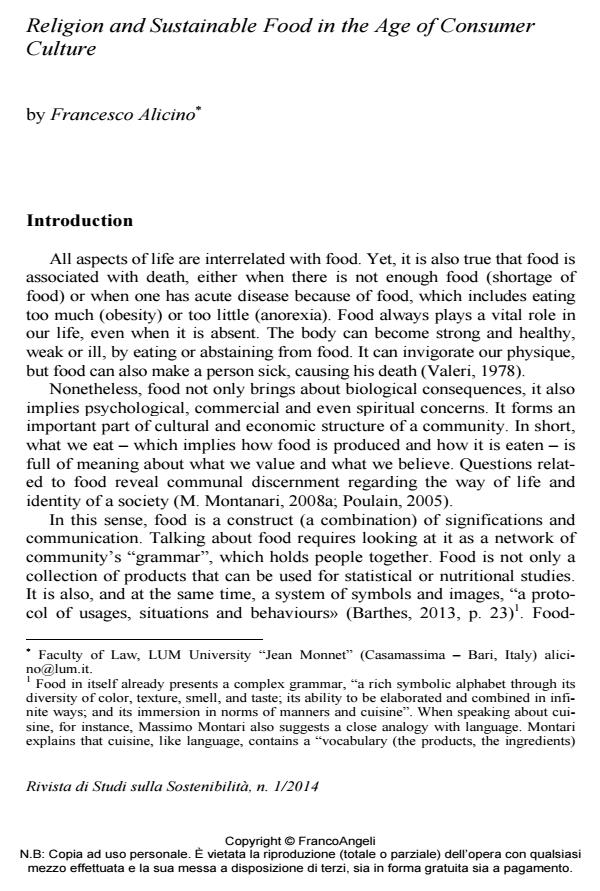Religion and Sustainable Food in the Age of Consumer Culture
Journal title RIVISTA DI STUDI SULLA SOSTENIBILITA'
Author/s Francesco Alicino
Publishing Year 2014 Issue 2014/1
Language Italian Pages 24 P. 101-124 File size 218 KB
DOI 10.3280/RISS2014-001007
DOI is like a bar code for intellectual property: to have more infomation
click here
Below, you can see the article first page
If you want to buy this article in PDF format, you can do it, following the instructions to buy download credits

FrancoAngeli is member of Publishers International Linking Association, Inc (PILA), a not-for-profit association which run the CrossRef service enabling links to and from online scholarly content.
Food is not only a collection of products that can be used for statistical or nutritional studies. It is also a system of symbols and images, a protocol of usages, situations and behaviours. And this may also involve a belief in spiritual, invisible and transcendent entities. In brief, it can infer religion. Besides, food consumption cannot be seen as an isolated and innocent act. On the contrary, it is a part of the chains of interdependencies, which bind people together across the world, calling for a change in eating behaviours. To become more sustainable, the act of consuming food needs to be changed, in order to decrease diseases caused by food, eliminating the unreasonable- unfair exploitation and distributions of earth’s natural resources. In order to understand if religion can be seen as a sustainable medium in alimentation, the Author will briefly evaluate some theological roots and religious practices associated with food. His attention is in particular focused on selected examples referring to main Abrahamic religious organizations, that is Catholicism and Islam. Then, he underlines the relationships and interconnections between religious rules and consumerism, the ways in which both are reacting to the problems related to food. In this sense, he tries to explore the interplay and intersections between religion and "consuming passions" in contemporary society. This analysis will lead to better understand how religious and secular values responses to above-mentioned problems; the ways in which both can contribute to a more sustainable-fairly food consumption.
L’alimentazione non può essere considerata solamente dal punto di vista statistico e nutrizionale: essa involge anche un sistema di immagini, situazioni e comportamenti, ivi compresi quelli afferenti alle credenze religiose. Allo stesso modo, l’atto di "consumare cibo" non può (non più) essere considerato con un atto isolato e innocente: al contrario, esso fa parte di una catena di elementi interdipendenti, che legano una quantità di persone, le quali ora sono chiamate a un comportamento alimentare più equo e salutare. Questo cambiamento e reclamato affinché il consumo di cibo possa diventare più sostenibile, dal punto di vista sociale e ambientale; riducendo contestualmente le malattie legate ai disturbi alimentari, nonché l’irragionevole distribuzione e sfruttamento delle risorse naturali. In questo senso, in vista di comprendere se la religione può svolgere il ruolo di "medium" per l’affermazione di un’alimentazione sostenibile, in questo saggio l’Autore valuta le radici teologiche e alcune pratiche religiose legate ai comportamenti sociali. L’attenzione è in particolare focalizzata su alcuni esempi tratti dalle più importanti religioni abramitiche, e segnatamente dal cattolicesimo e dall’Islam. Ciò consente di sottolineare le relazioni esistenti fra le regole religiose e la tendenza consumistica, il modo con cui questi due elementi stanno reagendo ai problemi inerenti al consumo alimentare. L’Autore esplora le intersezioni create fra la religione e la "passione consumistica" nelle società contemporanee. Un analisi, questa, che permetterà di comprendere al meglio come i valori religiosi e quelli secolari rispondono alle suddette problematiche, il modo in cui entrambi contribuiscono all’affermazione (o meno) di un più sostenibile consumo alimentare
Keywords: Food, religion, religious law; secular law, sustainability
Francesco Alicino, Religion and Sustainable Food in the Age of Consumer Culture in "RIVISTA DI STUDI SULLA SOSTENIBILITA'" 1/2014, pp 101-124, DOI: 10.3280/RISS2014-001007